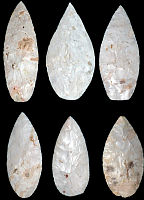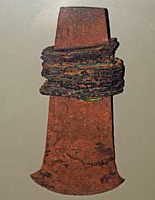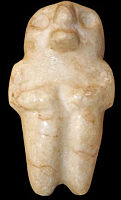|
See these, and more, in this issue of the Central States Archaeological Societies Journal

Click to enlarge
|
Classic Braden Style Birdman Shell Gorget, Castalian Springs
Site, Sumner County, Tennessee. Smithsonian Institution National Museum
of the American Indian, Washington, D.C.
Photograph by David H. Dye
See "A Spider Pendant by Dr. Sandy Carter, Roswell, Georgia" in the 2019
Central States Archaeological Societies April journal.
|

Click to enlarge |
Clifton blades are found in just a small area, and appear
to be a variety of an Adena “leaf” blade. They are almost
always made out of the same material, which seems to originate in the
local area, which is a heat-treated white chert that is of a very high
grade, with many blades exhibiting a high gloss or sheen. They are usually
lightly ground around the edges. Several large examples from a cache of
14 were shown in Flint Blades and Projectile Points by Lawrence(Red) Tully.
He mentions another cache of 9 blades, and it appears most examples have
been uncovered in caches. This cache of 6 blades was found by Byron Moore
in Humphreys County, Tennessee, the largest one measuring just over 6
inches. Photograph by Steven R. Cooper Collection of Dwight Phillips,
Lawrenceburg, Tennessee
See these and more in the 2019
Central States Archaeological Societies April journal.
|

Click to enlarge |
Large Mississippian copper celt with hafting stillpresent. Etowah Mounds, Cartersville, Georgia
See "Differentiating Archaic, Woodland and Mississippian Copper
Artifacts by E.J. Neiburger, Waukegan, Illinois" in
the 2019 Central States Archaeological
Societies April journal. |

Click to enlarge
|
Erben W. Reeder (1918-?) of Paducah, Kentucky, who
at one time had more than 200 worked fluorspar artifacts. He spent many
years hunting the Kincaid Mounds area. His finest, though not fluorspar,
was the effigy man figurine at the right, known today as the “snow
man.” It was found in 1968, near a firepit in the floor
of a Mississippian house. It
is made from a white mineral, barite (sometimes referred to as heavy
flourspar),
and is highly polished. It measures 4 ½ inches in height, 2 inches
in
width and 1 ½ inches thick. It has oval eyes that might have once
had shell
inlays and crossed arms. From the side, it appears to portray a toothless
old
man. It was originally pictured in the Central States Archaeological
Journal in
July 1970 on page 111. Photograph by Steven R. Cooper
See "Spar, Flourspar, Flourite and Kincaid Mounds by David Sullivan,
Mayfield, Kentucky" in the 2019
Central States Archaeological Societies April journal. |

Click to enlarge |
Sloan point from southern Illinois. Photograph by J. E.
Morrow.
See "What is a Sloan Point? by Juliet Morrow, Station Archeologist,
State University, Arkansas" in
the 2019
Central States Archaeological Societies April journal. |
HOME
|
|




